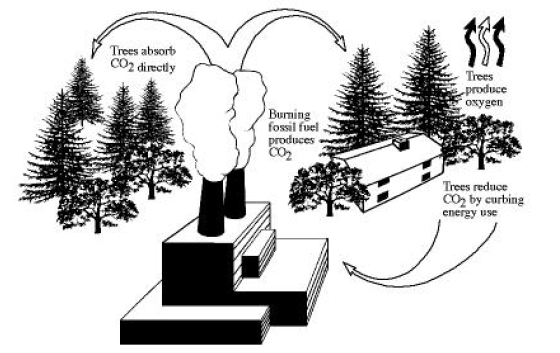The green belt is a specially designated area of countryside protected from most forms of development. It is protected to help stop urban sprawl, preserve the character of existing settlements and encourage development within existing built-up areas.
Air pollution comes primarily from burning fossil fuels, both for power generation and in vehicles. Low air quality has been implicated as causing numerous health problems and contributing to rising health care costs. Trees remove a significant amount of pollution from the atmosphere as part of their normal functioning. They directly increase the quality of the air in the city and its surrounding area and should be considered an integral part of any comprehensive plan aimed at improving overall air quality.

Trees: Part of the Air Pollution Solution
Trees provide a large leaf surface onto which particles are deposited and gases removed. Pollution is removed by nearly all parts of a tree; the soil, roots, and vegetative portions (leaves, stems, and bark) of urban forest ecosystems all function as sinks for atmospheric pollution. Trees “breathe”, or respirate, and exchange gases similar to the way humans do, yet the methods and results are quite different. Trees intake gases through stomates, or holes, on their leaves; these gases include those necessary for the tree’s functioning as well as other gaseous air pollutants. Once inside the leaf, gases diffuse into the spaces between the cells of the leaf to be absorbed by water films or chemically altered by plant tissues.
Trees also reduce air pollution by intercepting airborne particles and retaining them on the leaf surface, called dry deposition. Some can be absorbed by the leaf surface itself, although most remain on the plant surface.
Leaf surfaces are most efficient at removing pollutants that are water-soluble including sulfur dioxide, nitrogen dioxide, and ozone. Pollutant removal rates are highest when vegetative surfaces are wet or damp; these conditions can increase removal rates ten-fold because the surface of the entire tree (leaves, twigs, trunk, and branches) is available for pollutant uptake. Because of the drier climate, trees of the Front Range are not as efficient at removing airborne chemicals as trees in a humid climate.
Nakshatravanam:
In Hindu astrology, there are 27 or 28 nakshatras (“lunar mansions”), or sectors along the ecliptic. The concept of adoption of a plant is been derived from Indian cultural history. The Indian astrology is based on the concept of Nakshatras (Constellations) and Rashis (as per moon signs). There are in all 27 Nakshatras present in a year and every individual has a Nakshatra assigned to him/her depending on the date and time on which he/she is born (the tithi).
Every Nakshatra has a symbolic tree or plant that defines its connection with eternal nature. In our Indian culture there was a tradition that whenever a baby is born in someone’s home, that person was supposed to plant a tree of the same Nakshatra on which the baby was born. The person was supposed to take care of the tree as his child because it was believed that the more good and healthy the tree will grow, it will prosper more health and happiness to the child.
If these trees have been assigned to the 27 nakshatras by the Vedic Rishis, than it will be worthwhile for us to know which tree belongs to our JanmaNakshatra (Birth Constellation) and to have some idea about its medicinal values or other applications.
So the presence of the complete set of 27 trees directly creates a healthy and sound physical, mental, psychological and spiritual beings; which is the ultimate and absolute bliss to oneself and to the Earth too!
We, REST private limited, are committed to our vision “serving society through plantation” by implementing this “NakshatraVanam” concept.
